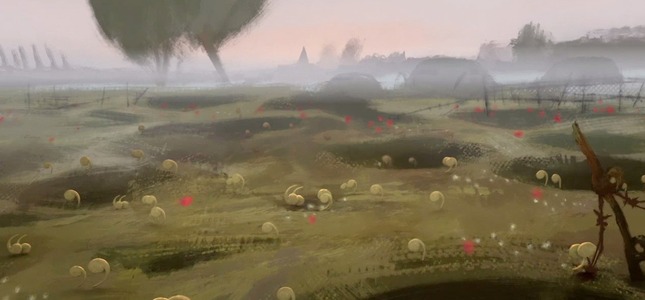
The video is a one and a half minute tribute to the people that didn’t return to the front line, using a little surrealism to create the poignancy of the peace. It starts out in the green fields of France, mixing traditional and 3D animation, to set the scene the shadowy spectre of barbed wire and dark, trench-like formations to allude to the past. Voices are given to the stories and letters of those that didn’t make it home in the form of grass-green quotation marks that fly over the channel, into London and up to the formidable stone of the Imperial War Museum.
It’s an impressive film and takes the Aardman outside of its usual furry faced stop-motion animation norms. The style is really unique as it blurs a painted landscape and background with the floating quote marks flying over battle scarred fields, the English Channel, over the Thames and through the city.
The galleries will be opening at the museum on the 19th July 2014 and entry is free to the public, so day one, the first weekend and the period of the centenary should see a lot of foot fall. The development of the galleries is part of a wider £40 million initiative to breath new life into the IWM London, which includes a new Atrium featuring massive displays, along with a number of new exhibitions, public spaces, shops and cafes.
When they open to the public the WW1 Galleries will feature more than 1,300 objects on display, including weapons, uniforms and equipment used in the war; diaries, letters, objects, photographs, and art from the front line, as well as film and art created during and soon after the war to capture the terror, valour and concerted effort that eventually led to peace. They have been drawn together from the Imperial War Museum’s large World War 1 collection and many of them have never been seen before on public display.
There’s a number of different sections to the galleries that are arranged to retell realities of the war through the eyes of people in
Britain and its empire, both on home soil and in the thick of the battle at the front line. You’ll get a chance to find out more about how the war started, why it took four years to come to a close, how it was won and what its impacts have been around the world.
World War 1 began on the 28th July 1914 in the aftermath of the assassination of Archduke Franz Ferdinand of Austria and didn’t end until the Allied forces defeated the central powers of Germany and its allies on the 11th November 1918. It resulted in more than 9 million fatalities and saw the majority of the world drawn into the battle, which was fought in Africa, the Middle East, the Pacific Islands, China and off the coast of South and North America, as well as in Europe.


